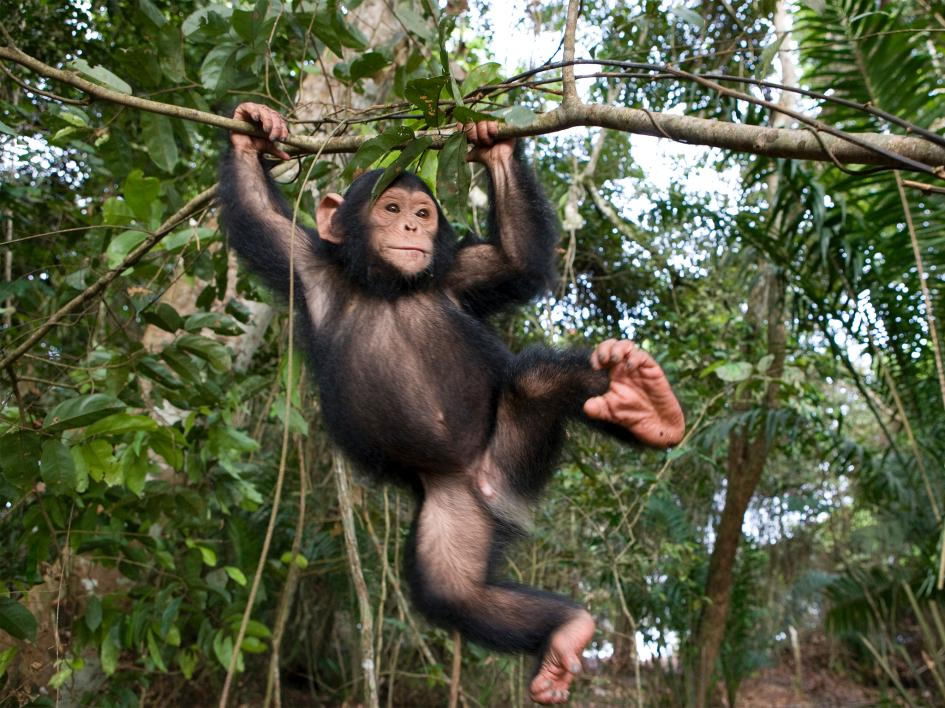
Did Humans Evolve Big Brains by Evolving Weak Muscles?
News to Know
Abstract
Are weak muscles the price humans paid for evolving bigger better brains?
News Sources
- ABC Science: “Human Muscles May Have Evolved More than Brain”
- PLOS Biology: “Jocks Versus Geeks—the Downside of Genius?”
How different are humans from chimps, monkeys, and mice? On a biochemical level, that is. More different than an international team of evolutionary biologists had suspected! These differences are pronounced in the brain’s prefrontal cortex and in muscles, but minimal in the rest of the brain and in kidneys. The researchers believe these differences help explain why humans are smarter while chimps and monkeys are stronger.
Biochemical Inventories
The researchers, whose paper “Exceptional Evolutionary Divergence of Human Muscle and Brain Metabolomes Parallels Human Cognitive and Physical Uniqueness” appears in PLOS Biology, sought to answer this question by identifying the amino acids, neurotransmitters, sugars, fats, nucleotides, and vitamins in the brains, muscles, and kidneys of healthy subjects. The team was taken aback by how very different our brains and muscles are from our supposed primate cousins. They were particularly shocked by the direction they believe evolution took as we diverged from our supposed common ape-like ancestor.
In “Jocks versus Geeks—the Downside of Genius?” Roland Roberts of the Cambridge Public Library of Science comments on this biochemical study of brains and brawn. “Somewhat narcissistically, one of the spectacular changes in phenotype that we tend to be most interested in is the enhancement in our own brain power which has occurred over the 6 million years that separate us from our last shared ancestor with chimpanzees,” he writes. “The chimp genome is famously very similar to our own, but the technological, linguistic, and cultural phenotype is clearly profoundly different.” This study of the biochemical inventory in various organs was aimed at discovering why we humans are so very different from primate animals.

Is this chimp doing pull-ups to make his muscles strong? No, apes and monkeys are designed with strong muscles as standard equipment. In a comparison with a group of humans, including trained athletes, “untrained” chimps and macaques consistently generated greater pulling force. Evolutionary researchers believe humans evolved with weaker muscles to allow for bigger better brains while chimps evolved stronger muscles, but they have no explanation for how this supposedly occurred nor any evidence that it did. Image by Michael Poliza, via National Geographic Creative.
Brains, Brawn, and Biochemistry
To find out, the team obtained samples of human, chimp, macaque, and mouse muscles, kidneys, and brain (prefrontal cortex, visual cortex, and cerebellum). They believe that chimp, macaque, and mouse ancestors diverged from the human lineage 6, 45, and 130 million years ago. Using mass spectrometry they characterized the various molecules present.
They were shocked to discover that the biochemical makeup of the human brain’s prefrontal cortex has “changed four times as rapidly in the last 6 million years as those of chimps.” The brain’s visual cortex and the kidneys were not biochemically different. The prefrontal cortex in humans is neurologically the seat of personality, social behavior, planning, complex thought, and decision-making. Thus the biochemical distinctions parallel the dramatic phenotypic differences in human and primate cognitive abilities.
The team was even more shocked to learn that the biochemical composition of human muscles “has experienced more than eight times as much change as its chimp counterpart.” In fact, they learned that the biochemical composition of homogenized human muscle is more similar to mouse muscle than to ape muscle. Roberts reports, “Indeed, metabolomically speaking, human muscle has changed more in the last 6 million years than mouse muscle has since we parted company from mice back in the Early Cretaceous. Most of the changes relate to pathways involved in the metabolism of carbohydrates and amino acids, and in energy production.”
Could the comparatively sedentary lifestyle typical of humans have caused the dramatic differences in the biochemical makeup of the muscles? To rule out this possibility a group of “macaques were subjected to aspects of the modern human ‘couch potato’ lifestyle for 2 months (limited exercise, stress, fatty and sugary diet), but this explained only 3% of the changes.” Thus it appears the differences in human and primate muscle composition are far more the result of genetic makeup and not environmental influence.
Flex Your Muscles
To see if differences in muscle composition parallel differences in strength, the team “conducted a series of experiments aimed at providing an approximate estimate of muscular strength in a pulling task.”1 Forty-two humans, five chimpanzees, and six macaques took part. “The task consisted of pulling suspended adjustable weights in a setup involving both upper and lower parts of the body.”2 The humans, maturity- and gender-matched to the animals, included five basketball players and four professional mountain climbers.
The animals performed far better than the humans, even the athletes. The animals, unlike the humans, were motivated by food rewards, so the team wrote, “The inability to control nonhuman primates’ motivation hinders the exact quantification of the muscular strength difference between humans and nonhuman primates, even in a highly controlled experimental setup.”3 They admit that there might be other reasons for the performance differences, such as the fact that the apparatus for measuring strength may have offered the animals an advantage in leverage. “Nonetheless,” they write, “our results indicate the existence of systematic differences in muscle performance between humans and nonhuman primates.”4
We hypothesize that metabolic evolution of human muscle and brain metabolomes may have occurred in parallel.
The team concludes that the differences in biochemical makeup of monkey-and-ape muscles and brains, compared to that of humans, coupled with the likelihood that monkeys and apes are stronger than humans, suggest humans were able to evolve bigger better brains by dramatically diverting resources from their muscles over evolutionary time. They haven’t performed any studies to compare the muscular endurance of animals and humans. However, given that selectively evolving a weakness would be oxymoronic within a survival-of-the-fittest evolutionary paradigm, they suggest human ancestors may have focused more on evolving muscular endurance. In any case, they conclude, “While the molecular mechanism linking metabolic divergence with changes in muscular strength on the human evolutionary lineage cannot be determined based on our observations alone, we hypothesize that metabolic evolution of human muscle and brain metabolomes may have occurred in parallel.”
Discovery Versus Interpretation
What the researchers have found in this study is that the biomolecular inventory of the human prefrontal cortex and human muscles differs substantially from that of chimps and monkeys. Humans excel at the activities governed by our prefrontal cortex, and chimps do not. Whether these differences are causally related to the statistical differences in biochemistry was not assessed. Whether the differences in muscle molecules is correlated with differences in muscular strength cannot be reliably determined from this study, given the methodological limitations of the strength testing.
Humans excel at the activities governed by our prefrontal cortex, and chimps do not.
Further study along these lines would require a better investigative design as well as a look at the specific interspecies biochemical differences with an eye to their functional significance. But the investigators seem less concerned with the physiologic significance of the differences they discovered and more concerned with their evolutionary origin. “The authors speculate,” Roberts reports, “that the fates of human brain and muscle may be inextricably entwined, and that weak muscle may be the price we pay for the metabolic demands of our amazing cognitive powers.”
Not only does the study stop short of pursuing the physiologic significance of these biochemical differences, but nothing in the study reveals the origins of these differences. Nor does anything in the study demonstrate humans evolved from an ape-like ancestor. The existence of differences—genetic, metabolic, biochemical, anatomic, or otherwise—does not reveal an evolutionary origin of differences.
These differences do not represent a timeline of evolutionary change because no molecules-to-monkey-to-man evolutionary change ever occurred. God created humans and all kinds of land animals on the same day, about 6,000 years ago, according to His own Word. Humans—created in the image of God— and all kinds of animals also reproduce only within their created kinds, just as the Bible describes in the first chapter of Genesis. Therefore, no evolution could have been involved.
God our Common Designer used variations of many common designs in humans and primate animals, but similar design does not demonstrate common evolutionary ancestry. There is no reason to be shocked about biochemical differences between muscles and the portion of the brain in which many of the dramatically different capabilities of humans and animals rest. God has told us our true history in His Word, and discoveries like these—divested of the baggage of evolutionary interpretations—are consistent with the history we find in the Bible.
Further Reading
- Did We All Come from Adam and Eve?
- How Did Birds Get To Be So Smart: Are They “Feathered Apes”?
- Were Birdbrains on the Dinosaur Pre-flight Checklist for Evolution?
- Nutcracker Man’s Diet Was Rich in Brain Food After All
- Brainfood: Cooking
- Genetic Roots of Tooth Enamel Reveal Distinctive Design
- Homo erectus Grew Teeth Like Modern Humans, Not Like Chimps
For More Information: Get Answers
Remember, if you see a news story that might merit some attention, let us know about it! (Note: if the story originates from the Associated Press, FOX News, MSNBC, the New York Times, or another major national media outlet, we will most likely have already heard about it.) And thanks to all of our readers who have submitted great news tips to us. If you didn’t catch all the latest News to Know, why not take a look to see what you’ve missed?
(Please note that links will take you directly to the source. Answers in Genesis is not responsible for content on the websites to which we refer. For more information, please see our Privacy Policy.)
Footnotes
- Katarzyna Bozek et al., “Exceptional Evolutionary Divergence of Human Muscle and Brain Metabolomes Parallels Human Cognitive and Physical Uniqueness,” PLoS Biology 12, no. 5: e1001871, doi:10.1371/journal.pbio.1001871.
- Ibid.
- Ibid.
- Ibid.
Recommended Resources

Answers in Genesis is an apologetics ministry, dedicated to helping Christians defend their faith and proclaim the good news of Jesus Christ.
- Customer Service 800.778.3390
- © 2024 Answers in Genesis




